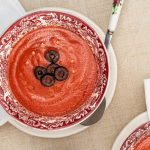From Galicia to Instagram: How ‘Cooking from Spain’ Is Reintroducing Spanish Food to the World
When Guillermo Varela left Galicia to live abroad — hopping from Santiago de Chile to Amsterdam, and eventually Berlin — he had no idea his life would take a sharp turn… back into his own kitchen.
It all started with tortilla. And a girlfriend.
While living in Berlin, Guillermo’s Austrian partner, Nina, couldn’t get enough of his Spanish cooking. She didn’t just love the food — she saw something deeper: a way to communicate culture through cuisine. Encouraged by her, Guillermo began sharing his traditional Spanish recipes in English on Instagram, targeting a foreign audience with little access to authentic Spanish food content.
The result? A viral sensation.
Now known as Cooking from Spain, Guillermo has built an international following of over 330,000 Instagram fans, millions of views, and a growing YouTube channel and newsletter — all centered around honest, flavorful, and deeply rooted Spanish dishes.
But his journey is about more than recipes.
📲 Content with Flavor — and a Point of View
What sets Guillermo apart isn’t just his food, but his storytelling. His videos are fast-paced, humorous, and effortlessly engaging. Whether he’s teaching how to make croquetas, explaining the origin of ensaladilla rusa, or defending the humble Spanish bocata, he brings history, context, and love to every frame.
Take his popular ensaladilla rusa video, for example. In it, he not only teaches the dish but addresses the controversy around its name with his signature wit:
“It’s as Spanish as my Spanish accent in English.”
Or his defense of Spanish sandwiches (bocatas):
“In other cultures, yes, you’ll find sandwiches. But not bocatas — the concept of a bar offering 30 combinations with protein, cheese, and veggies for under €10 is something very Spanish.”
Guillermo isn’t just teaching recipes — he’s exporting the everyday culture of Spain, one dish at a time.
👨🍳 From Engineering Student to Culinary Creator
Guillermo’s story begins in Bouzas, a neighborhood in Vigo, Galicia. He initially pursued a degree in industrial engineering but found more joy in cooking for his family than solving equations.
Encouraged by his father, he switched gears and enrolled at the Basque Culinary Center in San Sebastián, Spain’s most prestigious culinary school. The experience was formative — not because it made him want to be a restaurant chef, but because it helped him realize he didn’t.
“Studying at the Basque showed me how tough restaurant life really is,” he recalls. “I knew I wanted something different.”
That “something” became content creation. His previous job in food R&D, where he gave live product demonstrations, helped him sharpen his on-camera persona. But creating viral videos? Not as easy as it looks.
“People think it’s just filming a plate. But a 40-second video can take me 4 or 5 hours, between shooting and editing.”
🥘 Representing Spanish Food — Properly
One of Guillermo’s core missions is to fix misconceptions about Spanish cuisine. He’s especially passionate about showing the diversity within the country, such as the difference between paella in Valencia versus Galicia’s seafood traditions.
“In Galicia, you’d never eat paella like in the south, and in Seville, you’d never eat pulpo á feira like we do here.”
To him, Spain’s culinary treasure lies in its regional variety and product-first approach. That’s why he’s careful with what dishes he features — and how he talks about them.
“Spain hasn’t always marketed its food well to tourists. In some places, you’re sold a low-quality bocadillo de calamares in Plaza Mayor, and that becomes your impression of Spanish cuisine. That’s a shame.”
His goal: to use digital platforms as a better window into what Spain really eats — beyond tourist traps and stereotypes.
🎭 Accents, Criticism, and Staying Real
Despite his success, Guillermo hasn’t been immune to criticism — particularly about his Spanish-accented English. Ironically, the harshest comments have come from fellow Spaniards.
“Many people have never lived abroad and only know English from movies. But once you do, you realize everyone has an accent. That’s the beauty of it.”
His stats speak louder than any critics. Today, over 75% of his followers are from outside Spain, with big audiences in the U.S., U.K., and Germany.
🧆 Still a Chef at Heart
Though his main focus is online content, Guillermo keeps one foot in the real-world kitchen. He cooks at food festivals, pop-up events, and culinary showrooms — a way to stay grounded and get real feedback.
Most recently, he cooked two paellas and shrimp empanadas at the Caldo festival in Vigo, greeting followers in person and handing out hot food — not just reheated video leftovers.
“Nina always teases me that the videos look amazing, but we end up eating cold food,” he laughs.
If he ever opened a restaurant?
“It’d have tortilla, paellas, and ensaladilla rusa. Always.”
🇪🇸 Cooking from Spain, Sharing with the World
In a digital world overflowing with food content, Cooking from Spain stands out not because it’s trendy — but because it’s true. Guillermo brings humor, depth, and a sense of home to his videos. He’s not just cooking; he’s connecting. Teaching. Representing.
For every foreigner who thinks Spain is just tapas and sangría — or worse, only calamares en la Plaza Mayor — Guillermo’s here to say otherwise.
“Spain is more than that. Our food deserves to be known — and understood.”
And thanks to his camera, his accent, and his paella, it is.







